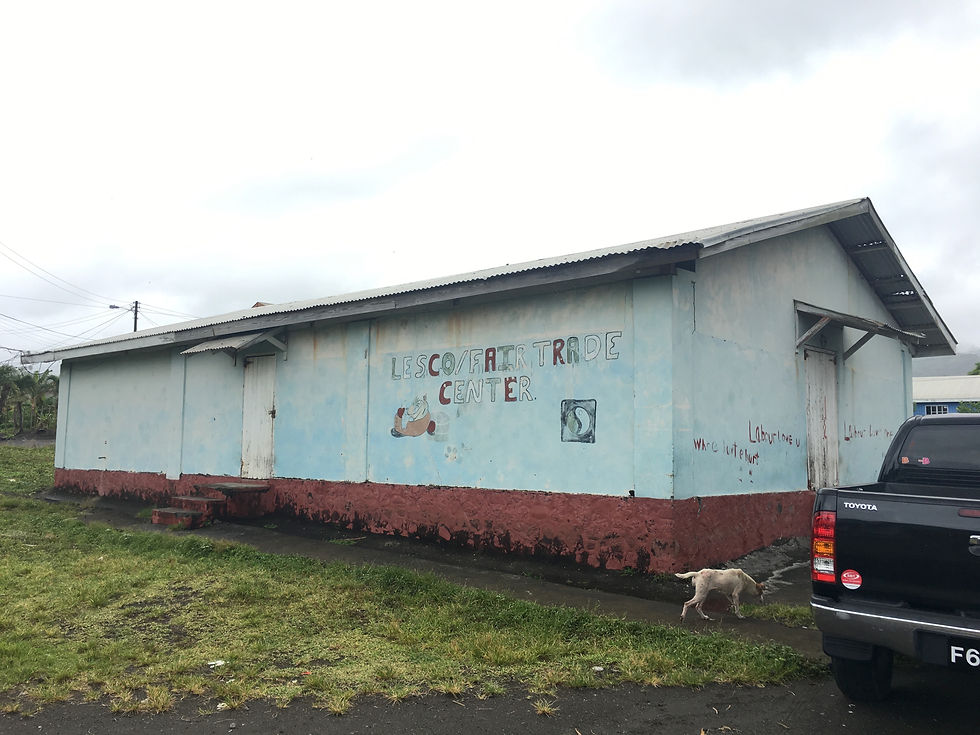First Impressions of SVG Agricultural Industry
- Victoria Dimick
- May 28, 2018
- 3 min read
I had my first encounter with the food system on the island on day one, when my supervisor, Ms. Edwards, kindly took me around to purchase whatever I needed for our new apartment. I arrived in St. Vincent with little prior knowledge about the country and its operations. I had read that its agricultural industry was a predominant segment of the country’s economy, and so my initial visit to the grocery store was a surprise! I was expecting to find heaps of local products but instead discovered more imported goods than local, and sold at a high cost. I quickly realized that the islands reliance on external trade for imported food, and the consequences associated with that- rising food prices and lowered food security- was one of the major challenges in the agricultural industry in St. Vincent.
Historically, agriculture was a leading industry in St. Vincent and the country was a major exporter of bananas and root crops. Unfortunately, due to globalization, disease and natural disasters some of these crops were wiped out in the early 2000’s. Since then, there has been a significant increase in imports, and an altered/ defeated/ hesitant mindset towards agriculture.
As the week continued, I learned that the best place to find fresh local products was from stalls on the side of the road, or, at the weekly farmer’s markets held around the island. It was here that I experienced the deliciously sweet and juicy mangos, green and ripe plantains, fresh soursop, and other tropical fruits native to St. Vincent. There was also an abundance of root crops being sold such as ginger, turmeric, cassava and sweet potato. Even local meat and fish can be purchased at their respective weekly markets.
I wondered why so much of this produce was not making it into the domestic retail market, or even regional markets, especially given the expensive price of imported goods. Having more of these local goods on the market would benefit everyone throughout the supply chain, from stabilizing producer incomes, reducing distribution and logistical costs for retail, and offering lower food prices for consumers.
In St. Vincent, the Ministry of Agriculture, Rural Transformation, Forestry & Fisheries (MARTFF) is working to revitalize the agricultural sector. One approach to this is by offering educational seminars to farm groups. I had the opportunity to travel ‘up countryside’ to visit the closely-knit farming communities where many local goods are produced, and participated in workshop seminars to educate farmers on value added products. I experienced two different farmer’s cooperatives: LESCO- a women’s farmer’s cooperative, and a co-ed livestock cooperative. I observed the obvious differences in the levels of enthusiasm from each group. At one, only six people slowly trickled in and were not engaged in the presentation until the end, after some motivation from the presenter. While the other group was eager, higher in number of attendees and arrived prepared and ready to learn. I could see that the apathetic attitudes of some of the farmers posed a challenge to the success of the Ministry’s objectives.
From this experience and further discussion with my colleagues in St. Vincent, I learned that although local goods are sold at the farmer’s markets, they do not make the grocery store shelves due to an inconsistent supply of quality products. In providing local producers with the knowledge to develop value added products, the MARTFF aims to create an industry for crops that would otherwise go to waste. I hope to learn more about MARTFF’s approaches to strengthen the agribusiness industry in St. Vincent.

Overlooking the Mesopotamia Valley, part of an ancient volcanic crater. Locally known as the 'breadbasket' of St. Vincent as its fertile soil was once responsible for much of the banana and root crop production on the island. Photo by Victoria Dimick, taken April 21st, 2018.

New Grounds Co-operative field station used for research and farmers learning. Photo by Victoria Dimick,
taken April 18th, 2018.

LESCO Fair Trade Centre in North Union, St. Vincent. Photo by Victoria Dimick, taken April 15th, 2018.

A MARTFF session at the New Grounds Livestock Cooperative. Here members learn how to 'ham' from the wonderful Dr. Philips, a way of adding value to their meat cuts for the market- or to enjoy at home! Photo by Victoria Dimick, taken April 17th, 2018.






Comments